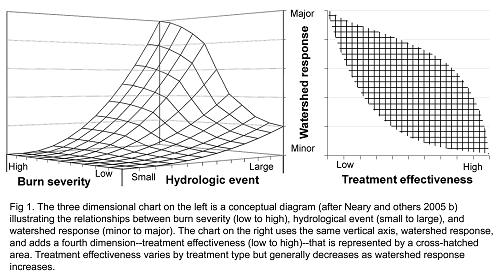Post-fire Treatment Effectiveness for Hillslope Stabilization
| Moscow FSL Home Page | |
| Personnel | |
| Engineering Publications | |
| BAER Tools | |
| Rocky Mountain Research Station | ||
| Forest Service Research | ||
|
|
||
| Summary | ||
| Summary table | ||
| Introduction | ||
| Treatment effectiveness & treatment performance | ||
| Factors that affect post-fire watershed response and treatment effectiveness | ||
| Erosion barrier treatments | ||
| Erosion barrier performance characteristics | ||
| Erosion barrier treatment effectiveness | ||
| Mulch treatments | ||
| Performance characteristics of mulches | ||
| Mulch treatment effectiveness | ||
| Chemical soil surface treatments | ||
|
Moscow Forestry Sciences Laboratory 1221 South Main Street Moscow, ID 83843 (208) 882-3557 7:30-4:30 M-F |
|
|
|
|
Factors that Affect Post-fire Watershed Response and Treatment Effectiveness
The same factors that increase the watershed response also decrease treatment effectiveness (fig. 1).
The specific environmental characteristics that impact post-fire treatment effectiveness have been divided into two groups–actors that are not fire dependent (such as topography and rainfall characteristics) and factors that are directly related to the fire (such as soil burn severity and the time since the fire).
Factors Unrelated to Fire
o Topography–The erosion rate generally increases as slope and hillslope length (flow path) increase. In addition, the drainage pattern (as determined by geologic terrain) can concentrate or dissipate erosive energy. Longer flow paths and convergent hillslopes (swales) allow overland flow to concentrate into rill flow, which has higher erosive power and causes the majority of surface erosion.
o Rainfall characteristics, especially rainfall intensity–Intense short duration storms, characterized by high rainfall intensity and low rainfall amounts, have been associated with high stream peak flows and significant erosion events after fires. The potential rainfall amounts, intensities, and seasonal patterns directly impact post-fire hillslope treatment effectiveness; it is essential to consider the potential rainfall regime of the burned area when selecting treatments.
Fire-dependent Factors
o Burn severity–The fire effects of soil heating and the consumption of organic material on the soil surface and near-surface lead to changes in soil properties that generally reduce soil infiltration and increase soil erodibility. The degree of soil burn severity is dependent on the peak temperatures and the duration of those temperatures within the soil. Observable post-fire ground parameters (for example, amount and condition of ground cover, ash color and depth, soil structure, presence of fine roots, and soil water repellency) are often used to classify soil burn severity.o Amount of bare soil–Amount of bare soil is an important factor used to map burn severity and has been positively related to post-fire erosion rates. In addition, there is evidence that post-fire erosion is reduced when natural mulch, such as conifer needle cast, provides protective post-fire ground cover or when hillslope treatments (straw mulch) provide immediate ground cover thereby reducing raindrop impact and shortening overland flow paths.o Time since the fire–Natural recovery of native vegetation reduces erosion over time. The greatest erosion usually is measured during the first post-fire year, and the second post-fire year and subsequent years can be an order of magnitude lower. However, recovery rates vary by climate and vegetation type.
o Soil water repellency–Fire-induced soil water repellency has been directly linked to soil burn severity and to reduced infiltration. Although the presence of fire-induced soil water repellency is generally confined to the top few inches of the soil, the presence and degree vary widely across the burned landscape. In addition, the effects of soil water repellency can vary over time depending on soil moisture, with water repellency being most pronounced during dry conditions and reduced or absent following prolonged wet conditions.
o Soil erodibility–Soil erodibility is an estimate of the ability of soils to resist erosion, based on the many factors, but predominantly on soil texture, soil structure, and organic matter content. When the organic material in the upper soil is consumed by fire, the soil can become disaggregated and, as a result, more erodible. In addition, the collapse in soil structure decreases total porosity and pore size which reduces infiltration rates.
|
The information on this web page has been excerpted from the following publication: Robichaud, Peter R.; Ashmun, Louise E.; Sims, Bruce D. 2010. Post-fire treatment effectiveness for hillslope stabilization. Gen Tech. Rep. RMRS-GTR-240. Fort Collins, CO: U.S. Department of Agriculture, Forest Service, Rocky Mountain Research Station. 62 p. |
USDA Forest Service - RMRS - Moscow Forestry Sciences
Laboratory
Last Modified: